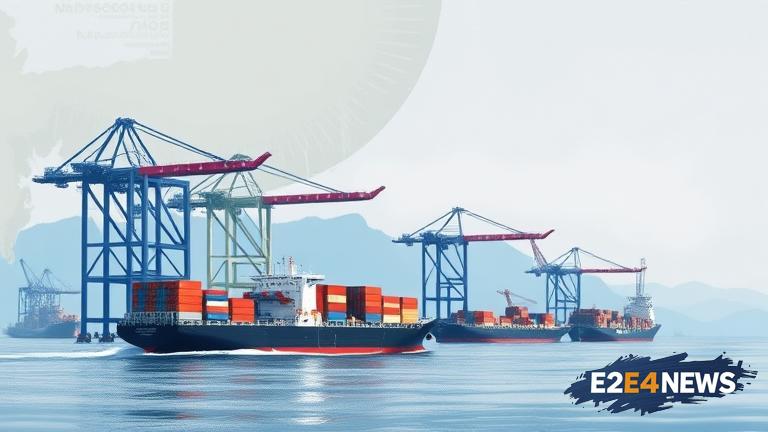The current state of the sea freight industry is experiencing a notable decline in rates from Asia to the US. This trend is expected to continue in the coming months, primarily driven by reduced demand and increased capacity. The decrease in demand can be attributed to a slowdown in global trade, while the increase in capacity is a result of new ship deliveries and services. As a consequence, shipping lines are facing significant pressure to maintain profitability. The Asia-US trade route is one of the most critical and competitive in the world, with numerous shipping lines operating on this route. The decline in rates is expected to have a significant impact on the industry, with shipping lines likely to implement various strategies to mitigate the effects. These strategies may include reducing services, increasing efficiency, and exploring new markets. The decline in rates is also expected to have a positive impact on importers and exporters, who will benefit from lower transportation costs. However, the decline may also lead to a decrease in service quality, as shipping lines may be forced to reduce their investment in maintenance and crew training. The current market conditions are highly competitive, with numerous shipping lines competing for market share. The decline in rates is expected to lead to a period of consolidation, with smaller shipping lines potentially being acquired by larger ones. The impact of the decline in rates will also be felt by ports and terminals, which may experience a decrease in volumes and revenue. The decline in rates is a global phenomenon, with rates on other trade routes also experiencing a decline. The World Shipping Council has predicted that the decline in rates will continue for the remainder of the year, with a potential recovery in 2026. The decline in rates is also expected to have a significant impact on the economy, with lower transportation costs potentially leading to an increase in trade volumes. However, the decline may also lead to a decrease in economic growth, as shipping lines and related industries may experience a decline in revenue. The current market conditions are highly uncertain, with numerous factors influencing the decline in rates. These factors include global trade policies, economic growth, and geopolitical events. The decline in rates is expected to lead to a period of significant change in the industry, with shipping lines and related industries adapting to the new market conditions. The impact of the decline in rates will be closely monitored by industry experts and analysts, who will be watching for any signs of a recovery. The decline in rates is a complex issue, with numerous factors influencing the trend. The current market conditions are highly competitive, with numerous shipping lines competing for market share. The decline in rates is expected to lead to a period of consolidation, with smaller shipping lines potentially being acquired by larger ones. The impact of the decline in rates will also be felt by ports and terminals, which may experience a decrease in volumes and revenue. The decline in rates is a global phenomenon, with rates on other trade routes also experiencing a decline. The World Shipping Council has predicted that the decline in rates will continue for the remainder of the year, with a potential recovery in 2026. The decline in rates is also expected to have a significant impact on the economy, with lower transportation costs potentially leading to an increase in trade volumes. However, the decline may also lead to a decrease in economic growth, as shipping lines and related industries may experience a decline in revenue. The current market conditions are highly uncertain, with numerous factors influencing the decline in rates. These factors include global trade policies, economic growth, and geopolitical events. The decline in rates is expected to lead to a period of significant change in the industry, with shipping lines and related industries adapting to the new market conditions. The impact of the decline in rates will be closely monitored by industry experts and analysts, who will be watching for any signs of a recovery. The decline in rates is a complex issue, with numerous factors influencing the trend. The current market conditions are highly competitive, with numerous shipping lines competing for market share. The decline in rates is expected to lead to a period of consolidation, with smaller shipping lines potentially being acquired by larger ones. The impact of the decline in rates will also be felt by ports and terminals, which may experience a decrease in volumes and revenue. The decline in rates is a global phenomenon, with rates on other trade routes also experiencing a decline. The World Shipping Council has predicted that the decline in rates will continue for the remainder of the year, with a potential recovery in 2026. The decline in rates is also expected to have a significant impact on the economy, with lower transportation costs potentially leading to an increase in trade volumes. However, the decline may also lead to a decrease in economic growth, as shipping lines and related industries may experience a decline in revenue. The current market conditions are highly uncertain, with numerous factors influencing the decline in rates. These factors include global trade policies, economic growth, and geopolitical events. The decline in rates is expected to lead to a period of significant change in the industry, with shipping lines and related industries adapting to the new market conditions. The impact of the decline in rates will be closely monitored by industry experts and analysts, who will be watching for any signs of a recovery.
